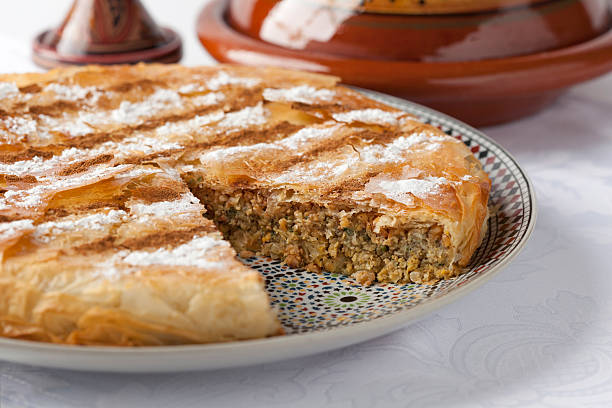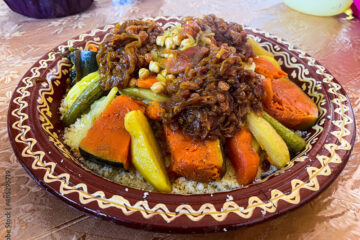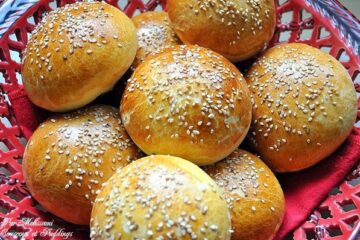As the Chef Gordon Ramsay said for the «YOU DECIDE» by pubity the best cusine in the world for 2024 is the moroccan cusine so for our first recipe it has to be a Moroccan recipe.
Ah, the Moroccan chicken pastilla – a true culinary gem that has captivated the hearts and taste buds of food lovers around the world. This delectable dish is a harmonious blend of savory, sweet, and flaky perfection, making it a must-try for anyone exploring the rich and diverse flavors of Moroccan cuisine.
In this post, we’ll dive deep into the history and traditions behind the chicken pastilla, uncover the essential ingredients and techniques, and provide you with a step-by-step guide to creating this authentic Moroccan masterpiece in your own kitchen. So, let’s get started on your journey to pastilla perfection!
The Origins of the Moroccan Chicken Pastilla
The Moroccan chicken pastilla, also known as bisteeya or bisteeya, has a long and storied history that dates back centuries. This iconic dish is believed to have originated in the city of Fez, the cultural and spiritual heart of Morocco, where it was traditionally served at special occasions and celebrations.
The pastilla’s roots can be traced back to the Andalusian cuisine of medieval Spain, where similar savory pie-like dishes were popular. When the Moors were expelled from Spain in the 15th century, they brought their culinary traditions with them, including the precursor to the modern-day pastilla.
Over time, the pastilla evolved and took on distinctly Moroccan flavors and ingredients, such as the use of spices like saffron, cinnamon, and ginger, as well as the incorporation of sweet elements like almonds and powdered sugar.
The Anatomy of a Perfect Moroccan Chicken Pastilla
At its core, the Moroccan chicken pastilla is a savory pie made with a flaky, paper-thin dough called warka or warqa, which envelops a rich and flavorful filling of seasoned chicken, eggs, and aromatic spices.
The key to a truly authentic pastilla lies in the balance of flavors and textures. The filling should be moist and tender, with a perfect blend of salty, sweet, and spicy notes, while the pastry should be delicate and crisp, providing a delightful contrast to the filling.
Here are the essential ingredients and techniques that make a Moroccan chicken pastilla truly shine:
The Filling:
- Chicken: Traditionally, a whole chicken is used, but you can also use a combination of chicken thighs and breasts.
- Onions: Finely chopped onions add sweetness and depth to the filling.
- Spices: Saffron, cinnamon, ginger, and white pepper are the signature spices that lend the pastilla its distinct Moroccan flavor.
- Eggs: Hard-boiled eggs are added to the filling, providing a creamy texture and a subtle richness.
- Almonds: Toasted, ground almonds add a delightful crunch and nuttiness to the filling.
The Pastry:
- Warka or Warqa: This paper-thin, flaky pastry is the hallmark of the Moroccan chicken pastilla. It can be homemade or store-bought.
- Butter or Clarified Butter: The pastry is brushed with melted butter or clarified butter, which helps create the signature flakiness.
- Powdered Sugar: A dusting of powdered sugar on the top of the pastilla adds a beautiful finishing touch and a lovely contrast to the savory filling.
The Step-by-Step Guide to Making Moroccan Chicken Pastilla
Now that you’ve learned about the history and key components of the Moroccan chicken pastilla, it’s time to dive into the recipe and start cooking!
Ingredients:
- 1 whole chicken, or 4 chicken thighs and 2 chicken breasts
- 1 large onion, finely chopped
- 1 teaspoon saffron threads
- 1 teaspoon ground cinnamon
- 1 teaspoon ground ginger
- 1/2 teaspoon white pepper
- 3 hard-boiled eggs, chopped
- 1/2 cup toasted, ground almonds
- 12-15 sheets of warka or warqa pastry
- 1/2 cup melted butter or clarified butter
- Powdered sugar for dusting
Instructions:
In a large pot, cover the whole chicken (or chicken pieces) with water and bring to a boil. Reduce the heat and simmer for about 45 minutes, or until the chicken is cooked through. Remove the chicken from the broth and let it cool.
Once the chicken is cool enough to handle, shred the meat off the bones and finely chop it. Set aside.
In a large skillet, sauté the chopped onion over medium heat until translucent, about 5-7 minutes. Add the shredded chicken, saffron, cinnamon, ginger, and white pepper. Cook for an additional 5 minutes, stirring frequently, to allow the flavors to meld.
Remove the chicken mixture from the heat and stir in the chopped hard-boiled eggs and ground almonds. Taste and adjust the seasoning as needed.
Preheat your oven to 375°F (190°C).
Lay a sheet of warka or warqa pastry on a clean, flat surface. Brush the pastry with melted butter or clarified butter. Place another sheet of pastry on top and brush with more butter.
Spoon a portion of the chicken filling onto the center of the pastry, leaving a 2-inch border on all sides.
Fold the sides of the pastry over the filling, then roll the pastilla into a tight cylinder, ensuring that the seam is on the bottom.
Carefully transfer the pastilla to a baking sheet, seam-side down. Repeat the process with the remaining pastry and filling.
Bake the pastillas in the preheated oven for 25-30 minutes, or until the pastry is golden brown and flaky.
Remove the pastillas from the oven and let them cool for 5-10 minutes. Dust the tops generously with powdered sugar.
Serve the Moroccan chicken pastillas warm, and enjoy the perfect balance of savory, sweet, and flaky perfection!
Tips and Variations
- For a truly authentic experience, try to find and use warka or warqa pastry. If it’s not available, you can substitute with phyllo dough or even puff pastry.
- Experiment with different spice blends, such as ras el hanout, to add even more depth of flavor to the filling.
- Consider adding a touch of orange blossom water or rosewater to the filling for a subtle floral note.
- Serve the pastillas with a side of fresh mint tea or a simple green salad for a complete Moroccan-inspired meal.
Conclusion
There you have it, the secrets to creating an authentic Moroccan chicken pastilla in your own kitchen. This dish is a true testament to the rich culinary heritage of Morocco, blending savory, sweet, and flaky elements into a harmonious and unforgettable experience.
Whether you’re a seasoned Moroccan cuisine enthusiast or a curious foodie looking to explore new flavors, this Moroccan chicken pastilla recipe is sure to delight and transport you to the vibrant markets and spice-filled streets of this enchanting North African country. So, what are you waiting for? Grab your apron and get ready to embark on a delicious Moroccan adventure!




